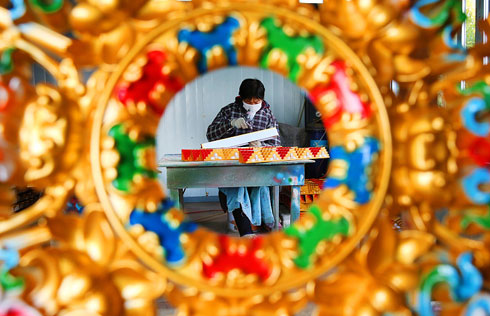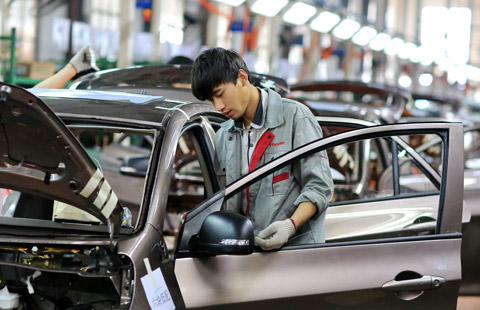Why China's massive steel lay-offs will not hurt economy
BEIJING — Like many other overstaffed steel producers in China, Magang (Group) Holding, or Masteel, is in the middle of downsizing.
The steel complex in East China's Anhui Province made more than 4,000 workers, or 10 percent of total staff, redundant last year as it cut nearly 5 million metric tons of capacity.
Of the redundancies, half were older employees opting for early retirement, and over 40 percent were retrained and remployed for new positions in the factory.
The settlement, despite adding to corporate costs, has paid off.
Thanks to slimmer operation and stronger competitiveness in advantageous products, Masteel's Shanghai-listed branch posted a net profit of 2.74 billion yuan ($425 million) in the first three quarters, more than double from a year ago.
Masteel is typical of enterprises in glutted steel and coal sectors where the government is pushing for consolidation.
China plans to eliminate 100 million to 150 million tons of crude steel capacity in five years from 2016, and 500 million tons of coal. After the process around 1.8 million employees will no longer be needed, official data shows.
Concerns have lingered on whether this wave of industrial restructuring will be similar to those in state-owned enterprises in the 1990s and result in a surge in the jobless rate, and even trigger social and economic instability.
"The placement of those laid-off is usually a thorny issue in resource-based cities and monotowns where the group of unemployed is huge and job vacancies are scarce," said Liu Yanbin, former president of the Chinese Academy of Labour and Social Security, a government think tank.
For Masteel, it was not an easy task: a special panel was established, staff were consulted and all plans had to be passed in a workers congress.
"It was completed in a smooth and orderly manner," the company said in a statement.
Sun Shufeng, a 39-year-old furnace worker, used to worry that his 16 years of experience in Masteel would not be able to help him secure a job elsewhere, until job-transfer training made him competent in spray casting.
"I do not earn as much now but I am still satisfied as the job is stable," Sun said.
Analysts believe the impact of capacity cuts on unemployment and the social welfare burden is limited.
Under the last SOE reforms around two decades ago, it was estimated that tens of millions of workers were dismissed within a couple of years, a significant shake-up given that China's urban workforce only totaled 190 million in 1995.
"With the present economic size and fiscal strength, China can handle the problem more easily," said Tang Jianwei, chief macro analyst with the Bank of Communications. "Not only does GDP amount to nearly $12 trillion, from less than 1 trillion dollars around 20 years earlier, but the national income per capita has risen to 8,800 dollars from 1,000 dollars."
Rather than simply shutting down factories, the government is now encouraging market approaches, such as mergers and acquisitions and targeted removal of outdated capacity.
Thanks to the strategy, the lay-offs from steel and coal sectors accounted for a much smaller fraction of the working population.
"The expected 1.8-million unemployed was merely 0.4 percent of the country's 410 million urban workforce," Tang said.
During the first 10 months of the year, nearly 12 million jobs were created, surpassing the annual goal and bringing the jobless rate to its lowest level since 2008.
"Given the robust job increases, the spare labor force can be quickly absorbed by other industries," said Steven Zhang, chief economist with Morgan Stanley Huaxin Securities.
With employment high on its work agenda, the government has stepped up efforts to help redundant workers, with measures ranging from skill training to financial support.
A fund of 100 billion yuan has been allocated to support workers after redundancy, according to the Ministry of Finance.
Minister of Human Resources and Social Security Yin Weimin has called employment the "ballast stone" of social and economic stability. Around 13 million jobs were generated every year since 2012. During the past five years, the government has helped 27.9 million people find new jobs.
While ruling out the possibility of major risks, Zhang said central authorities should still be prepared to step in with fiscal support for local governments in case of a partial jobless surge.
"In the long run, monotowns should push forward industrial upgrades, shifting from resource-reliant sectors to high-tech manufacturing and services," Zhang said. "In fact, the government should gradually shift to tackling the labor shortage as an aged population is taking shape."
The population aged between 16 and 60 was 910 million last year, marking a decline for the fifth straight year, data from the National Bureau of Statistics shows.
- Shareholder contribution dispute between Benxi-based Beifang Coal Chemical Co, Ltd, Panhai International Co, Ltd and Taipei Steel Group Co, Ltd
- Steel, home appliances lead stock rally
- High-end steel manufacturer goes green after being in red
- Steel demand growth expected to stay flat next year
- Kobe Steel scandal exposes fault line in 'Made in Japan' program

























